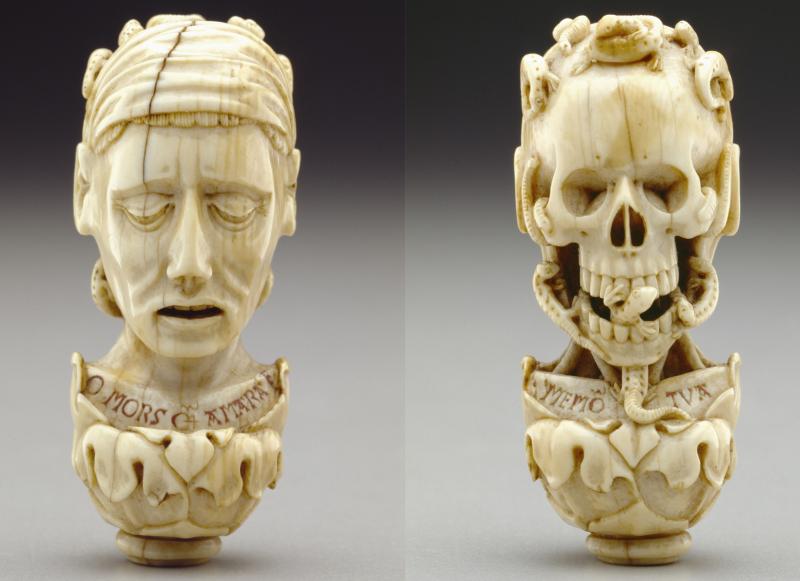Renaissance artist exhibition at BCMA

The Bowdoin College Museum of Art (BCMA) will soon open a groundbreaking exhibition on the visual culture of mortality and morality in early Renaissance Europe. On view from June 24 to Nov. 26, “The Ivory Mirror: The Art of Mortality in Renaissance Europe” reveals how, in an increasingly complex and uncertain world, Renaissance artists sought to address the critical human concern of acknowledging death while striving to create a personal legacy that might outlast it.
Curated by Stephen Perkinson, Peter M. Small Associate Professor of Art History at Bowdoin College, The Ivory Mirror brings together exceptional examples of memento mori, a genre of artistic and literary imagery that emerged in the early Renaissance to remind viewers of their inevitable death, to question how art historians have conventionally interpreted these objects and to propose new ways of considering their significance. In conjunction with the exhibition, a dynamic series of public programs throughout the summer and fall, ranging from film screenings to gallery talks to interdisciplinary programs with health care experts and scholars, will provide illuminating perspectives on death and the choices we make in life. An international symposium will convene distinguished scholars to address the intersection between a fascination with death, luxury, and new techniques of representation in Renaissance Europe.
The Ivory Mirror will bring together nearly seventy exquisite artworks, many of which have never been seen before in North America, from European and American institutions—among them the Victoria and Albert Museum in London, the Metropolitan Museum of Art in New York, and The Huntington Library in San Marino. New scholarship across the humanities features critical new discoveries, such as the attribution of several ivories, of previously uncertain authorship, to Chicart Bailly, a prosperous ivory carver active in Paris from at least the 1490s until 1533. The precious objects included in the exhibition—from ivory prayer beads and gem-encrusted jewelry to exquisitely carved small table sculptures—draw attention in spectacular fashion to the depictions of death, dying, and decay that proliferated in popular culture between the fifteenth and seventeenth centuries, when mortality rates were perilously high. The appeal of objects featuring macabre imagery urging us to “remember death”— and, by implication, to consider how best to take advantage of our time on earth—reached the apex of its popularity around 1500, when artists treated the theme in innovative and compelling ways.
An elegant installation, organized into eight thematic sections, focused on subjects such as selfhood, morality, piety, and anatomy, enables audiences to understand the broad range of inspirations for and implications of memento mori imagery. Cases provide the opportunity to see ivory prayer beads and other statuettes in the round and in the context of paintings and prints from the period by leading artists such as Albrecht Dürer and Hans Holbein. Magnifying glasses further permit close examination of the exceptional detail with which artists of the period wrought the ivory objects brought together for the first time in The Ivory Mirrror.
The BCMA will display highlights from their own collection alongside artworks loaned from the Victoria and Albert Museum, the Ashmolean Museum at the University of Oxford, the Philadelphia Museum of Art, and the Walters Art Museum among others. Highlights of the exhibition include:
Several stunning momento mori ivory pendants and rosary beads on loan from the Victoria and Albert Museum, the Metropolitan Museum of Art, the Philadelphia Museum of Art, the Walters Museum of Art, and from the BCMA’s own collection; and Hans Holbein the Younger’s Dance of Death woodcut series, on loan from the Museum of Fine Arts, Boston; A boxwood sculpture from the School of Conrad Meit, Vanitas, ca. 1525, on loan from the Harvard Art Museums; A copy of Andreas Vesalius’s momentous anatomical compendium, On the Fabric of the Human Body of 1543, on loan from Francis A. Countway Library of Medicine, Harvard University; Illuminated manuscripts and early printed books of the fifteenth and sixteenth centuries on loan from the Huntington Library, Art Collections, and Botanical Gardens, San Marino, California and the Clapp Library of Wellesley College; Albrecht Dürer’s engraving The Fall of Man (Adam and Eve), 1504, from the collection of the BCMA; Masterful decorative arts objects on loan from the Victoria and Albert Museum by unknown artists, including an early seventeenth-century gold and enamel ring, an enameled, jewel-encrusted gold brooch, and a silver scent case from the early sixteenth century.
The Museum will host a series of exhibition related public programs throughout the summer and fall, including an opening keynote lecture by curator Stephen Perkinson, gallery talks by scholars and artists, as well as an international symposium that will draw numerous disciplines into dialogue around the rise of memento mori imagery during the European Renaissance. our mortality, both historically and in present day. For more information, visit www.bowdoin.edu/art-museum or call 207-725-3275.
Fully accessible, the Bowdoin College Museum of Art, located at 9400 College Street in Brunswick, is open to the public free of charge from 10 a.m. to 5 p.m. on Tuesday through Saturday; 10 a.m. to 8:30 p.m. on Thursday, and from 1-5 p.m. on Sunday.
























